 |

For further information, contact the MBL Communications Office at (508) 289-7423 or e-mail us at comm@mbl.edu
FOR IMMEDIATE RELEASE: April 21, 2011
Contacts:
Diana Kenney, MBL, 508-289-7139; dkenney@mbl.edu
Jade Boyd, Rice University, 713-348-6778; jadeboyd@rice.edu
 |
 |
 |
Resources
Video:
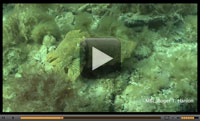
Cuttlefish, as shown in this video, have extraordinary camouflage skills. They also have light-sensing proteins distributed throughout their skin. How these proteins interact with the animal's visual system to enable instantaneous changes in skin pattern and color is a focus of Roger Hanlon's research at the MBL. Credit: Roger Hanlon Watch the video.
Photos:
Click on thumbnail for large image.
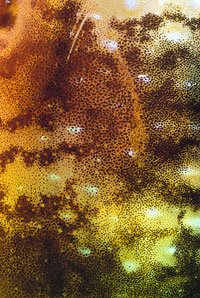
Chromatophores and structural reflectors (iridophores and leucophores) are responsible for the complex patterning seen in this close-up image of cuttlefish (Sepia latimanus) skin. Photo by R. Hanlon
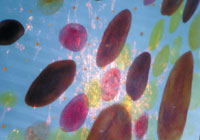
Chromatophores (large brown, red and yellow structures) and iridophores (pink iridescent spotches) in squid Loligo pealeii. Photo by L. Mäthger
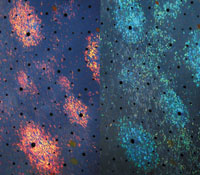
Iridophores in squid are highly angle dependent. This image shows the same iridophore splotches viewed at normal (red) and oblique (blue) viewing angles. Photo by L. Mäthger
|
The Ultimate Camo:
Team to mimic camouflage skill of marine animals in high-tech materials
WOODS HOLE, MA—Camouflage expert Roger Hanlon of the Marine Biological Laboratory (MBL) is co-recipient of a $6 million grant from the Office of Naval Research to study and ultimately emulate the exquisite ability of some marine animals to instantly change their skin color and pattern to blend into their environment.
|
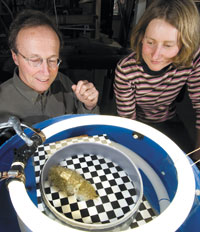
Hanlon and Mathger: MBL Senior Scientist Roger Hanlon and Assistant Research Scientist Lydia Mäthger test the ability of a cuttlefish to adapt to a disruptive background pattern. Photo by T. Kleindinst.
|
 |
Roger Hanlon Laboratory
|
|
Hanlon, who has spent more than three decades studying the camouflage artistry of squid, octopus, and cuttlefish (a class of animals known as the cephalopods), is collaborating with materials scientists and nanotechnologists at Rice University toward the goal of developing materials that can mimic cephalopod camouflage.
“Our internal name for this project is ‘squid skin,’ but it is really about fundamental research,” says Naomi Halas, an expert in nano-optics at Rice University and the principal investigator on the four-year grant. “Our deliverable is knowledge, the basic discoveries that will allow us to make materials that are observant, adaptive, and responsive to their environment.”
In 2008, Hanlon and MBL colleagues Lydia Mäthger and Steven Roberts discovered that cephalopod skin contains opsins, the same type of light-sensing proteins that function in the eyes.
“This project will enable us to explore an exciting new avenue of vision research – distributed light sensing throughout the skin,” Hanlon says. “How and where that visual information is used by the nervous system is likely to uncover some novel neural circuitry.”
Hanlon and his team will perform experiments with cephalopods to determine how opsin molecules receive light and aid the animal’s visual system in adjusting skin patterns for communication and camouflage. A wide range of techniques will be used to accomplish these aims. The MBL team, which includes scientists Mäthger and Alan Kuzirian, will be collaborating with marine biologist Thomas Cronin of the University of Maryland, Baltimore County, on these investigations.
“This is inherently a multidisciplinary problem,” Halas says. “What can we, as engineers, learn from the way these animals perceive light and color?” The project team’s engineers will focus on emulating cephalopod skin using new metamaterials—materials that blur the line between material and machine.
The Marine Biological Laboratory (MBL) is dedicated to scientific discovery and improving the human condition through research and education in biology, biomedicine, and environmental science. Founded in 1888 in Woods Hole, Massachusetts, the MBL is an independent, nonprofit corporation.
Selected Publications:
Mäthger, L.M., Roberts, S. and Hanlon, R.T. 2010. Evidence for distributed light sensing in the skin of cuttlefish, Sepia officinalis. Biology Letters 6: 600-603. (PDF)
Mäthger, L.M., Denton, E.J., Marshall, J. and Hanlon, R.T. 2009. Mechanisms and behavioral functions of structural coloration in cephalopods. Journal of the Royal Society Interface 6: S149-S164. (PDF)
Sutherland, R. L., Mäthger, L. M., Hanlon, R. T., Urbas, A. M., Stone, M. O. 2008. Cephalopod coloration model. I. Squid chromatophores and iridophores. Journal of the Optical Society of America, 25 (3): 588-599. (PDF)
Mäthger, L.M., and Hanlon, R.T. 2007. Malleable skin coloration in cephalopods: selective reflectance, transmission and absorbance of light by chromatophores and iridophores. Cell and Tissue Research 329: 179-186. (PDF)
|